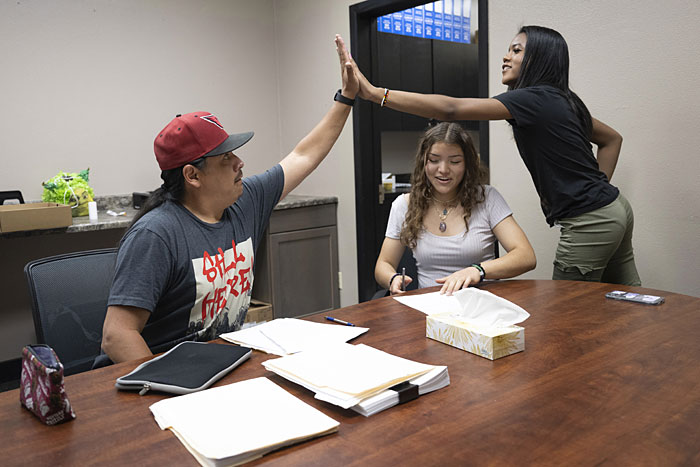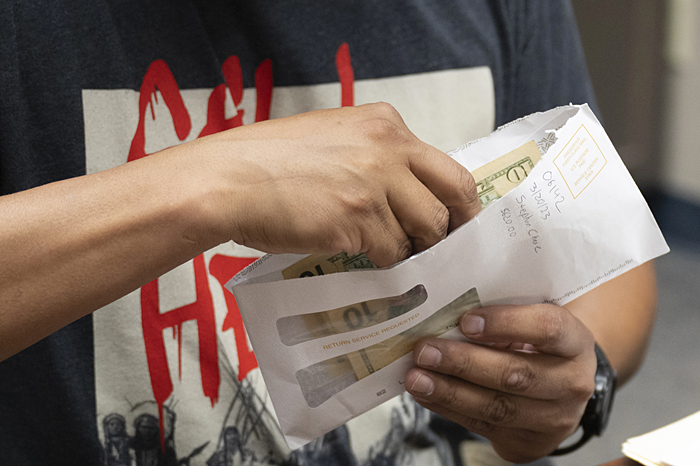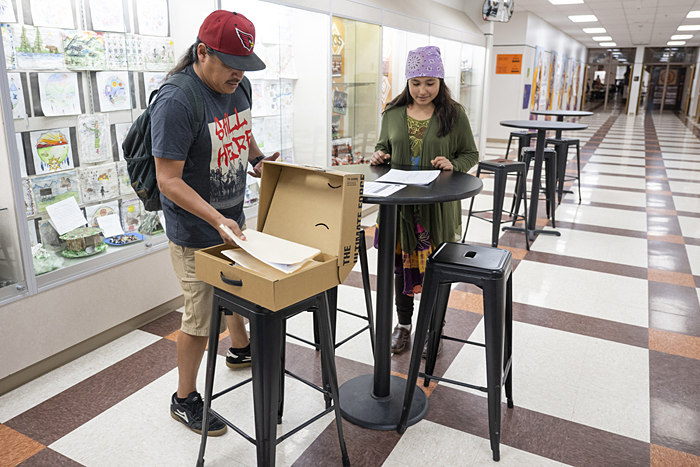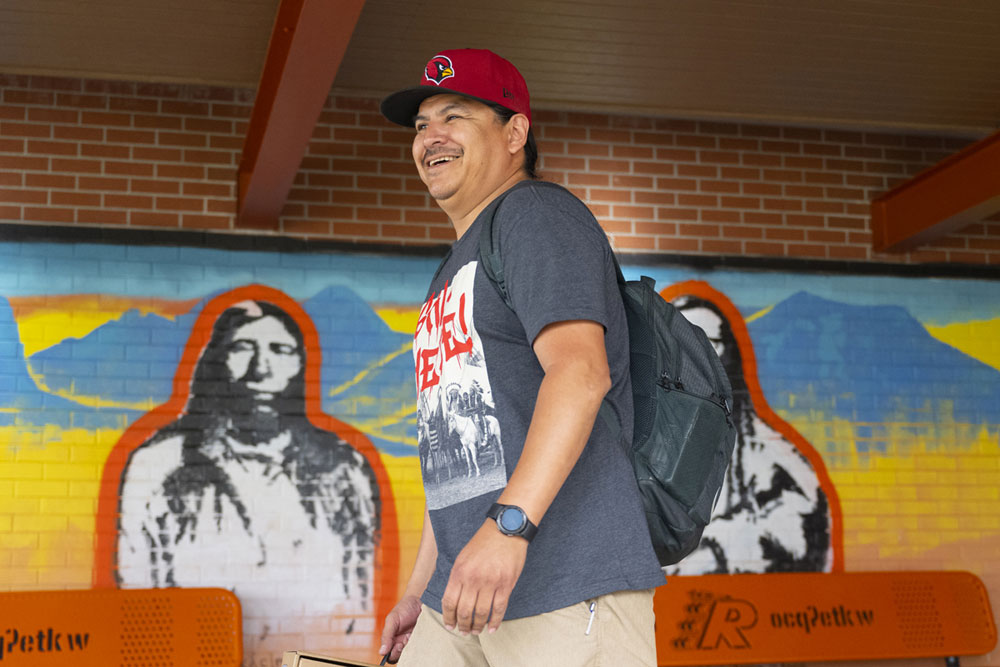Native Middle and High School Students Study STEM Through UM Program

By Abigail Lauten-Scrivner, UM News Service
MISSOULA – Over 100 students will soon move onto the University of Montana campus and spend part of their summer vacation building their own computers, learning about color wavelengths and studying river ecology while floating the Clark Fork. The students will live like college freshmen – eating at the Food Zoo, going to class and learning about the environment around them – but none are older than a high school junior.
It’s the culmination of a year of hard work and anticipation for middle and high school students in the Montana American Indians in Math and Science (MT AIMS) program. The MT AIMS summer camp brings together students from Montana and beyond – largely from Native communities – to forge friendships, gain STEM skills and build pathways to college.
The camp enters its fifth summer this year. The first student cohort from 2019 are now juniors pondering life after high school. Many are considering college – an indicator to MT AIMS Associate Director Stephan Chase that the program is working.
“I don’t think they’d be considering that so much if they didn’t have a program like this,” said Chase, a member of the Diné (Navajo Nation). “This program has the potential to change the lives of kids from Native communities. I see that looking at the juniors we have now and hearing how they talk about going to school. I think that’s a big step.”
Native Americans fall behind other non-white student groups in higher education and account for the lowest graduation rates, according to the U.S. Department of Education.
“In general, if you look at the number of Native students that exist at most college campuses, it’s less than 1%,” said Aaron Thomas, a UM chemistry professor and director of MT AIMS and the University’s Indigenous Research and Stem Education program. “Either Native students are lumped in with other groups, or they’re not even considered.”
“When we talk about STEM, it’s much, much lower,” added Thomas, also a Diné tribal member.
MT AIMS intends to change those statistics with free STEM education for Native students. The hope is that those who are interested in college will feel empowered to go.
“It's really fun to experience, because you get a view of what college might be like,” said Aaliyah Tucker, an eighth grader at St. Ignatius Public Schools with dreams of an entrepreneurship, modeling and acting career.
Tucker has ambitions of expediting those dreams when she begins high school by getting ahead with dual enrollment and Montana Digital Academy. She credits MT AIMS with helping her realize those goals and motivate her to achieve them.
“My grades have gotten better,” she said.
Earning good grades is a prerequisite for returning to MT AIMS summer camp. Chase works year round to help them meet the minimum grade requirement of a C-average.
During a recent mid-May morning, Chase loaded a rental van with a thermos of hot coffee, crisp $10 bills and grade reports before heading north for a monthly grade check with MT AIMS students on the Flathead Indian Reservation.
Chase makes trips every month, sometimes driving all day to Native communities in eastern Montana and staying overnight. The May trek included stops at Ronan Middle School, Ronan High School and St. Ignatius Public Schools.

The students buzzed as they gathered, discussing the end of the school year and asking about summer plans, wondering if they’d see each other at UM for camp, while Chase pulled each aside one by one to review grades.
Students with at least C-average grades receive a stipend of two $10 bills – never a single $20, as Chase doesn’t want to hand Native kids money with President Andrew Jackson’s face, who signed the Indian Removal Act into law. Ronan High School student Aaliyah Stewart let out a whoop of glee and high-fived Chase after receiving her $10s for the first time this spring.
Chase encourages those with lower than a C average to raise their grades, emphasizing how their friends at camp will miss them. He discusses strategies like turning in partially done assignments, boosting grades with upcoming coursework or tutoring.
“I’ll totally bust it out these last two weeks,” promised JuDaya Azure-Matt, an eighth grade Ronan Middle School student.
Having first enrolled in MT AIMS as a sixth grader, Azure-Matt was eager to attend camp again. She described it as an open and free experience that pushes her to succeed in ways she previously didn’t believe she could, especially as a middle schooler. Supportive counselors and instructors, many of whom are Native, allowed her to challenge herself in a safe environment.

“They didn’t give us lots of limitations that normal kids would have. They trusted us,” Azure-Matt said. “That really gave me some faith in myself.”
Besides typical camp activities like playing basketball and hiking the campus M Trail, students take on more advanced activities, like coding drones. Each begin their first year building a computer – something Azure-Matt never imagined she could do. If students pass Algebra 1 with a C or better, they get to keep it.
Not every camper is Native, but each share the experience of growing up in Indigenous communities. A majority hail from Montana, but some trek from Maryland, Nevada and Arizona.
Azure-Matt was struck by how holistic lessons were, often synthesizing Western science with Indigenous ways of knowing from her culture, like teaching math through traditional games. That integration is a pivotal and intentional aspect of the long-term vision for MT AIMS.
“We’re trying to link STEM activities and slowly incorporate traditional and Native ways of knowing to show that practices handed down for millennia are actual science practices,” Chase said. “Native communities have always had science; it just wasn’t called that. It just wasn’t the Western, academic version of science. It was a way to survive, it was knowing when to migrate from one place to another.”
Showing Indigenous students how science is – and always has been – embedded in their communities builds confidence that they, too, have a place in STEM. The intention is similar in recruiting Native college-level camp counselors who become friends and mentors to campers.
“It‘s nice to show students these role models so they say, ‘Okay, they made it, and I can make it as well,’” Thomas said. “They see that there is a pathway.”
Making friends with counselors and fellow campers is the highlight for MT AIMS students. Many keep in touch all year until reuniting at camp.
“I’d never really made good friends like that before,” Azure-Matt said.
Talking with counselors about their college experiences piqued her attention. Interested in both science and art, she hopes to attend UM after high school.
The long-term vision for MT AIMS is to further serve students like Azure-Matt through graduate school. Thomas envisions creating stronger pathways for Native students to graduate college by developing additional programs similar to UM’s Indigenous First Year Experience, linking Native students with internships in their second year of college.
One imminent change is Chase’s bittersweet departure for a new role in New Mexico at the end of the summer. “I’ll really miss those kids,” he said.
After he’s gone, Chase hopes MT AIMS students will graduate high school, then college, and use their degrees to give back to their communities. Or at the very least, return to camp as a counselor and become a role model themselves.
###
Contact: Aaron Thomas, UM director of Montana American Indians in Math and Science, 406-243-2052, aaron.thomas@mso.umt.edu; Stephan Chase, associate director of MT AIMS, stephan.chase@umontana.edu.
